
The Fokker Dr.I, often known simply as the Fokker Triplane, was a World War I fighter aircraft built by Fokker-Flugzeugwerke. The Dr.I saw widespread service in the spring of 1918. It became famous as the aircraft in which Manfred von Richthofen gained his last 17 victories, and in which he was killed on 21 April 1918.

The Fokker Scourge occurred during the First World War from July 1915 to early 1916. Imperial German Flying Corps units, equipped with Fokker Eindecker fighters, gained an advantage over the Royal Flying Corps (RFC) and the French Aéronautique Militaire.
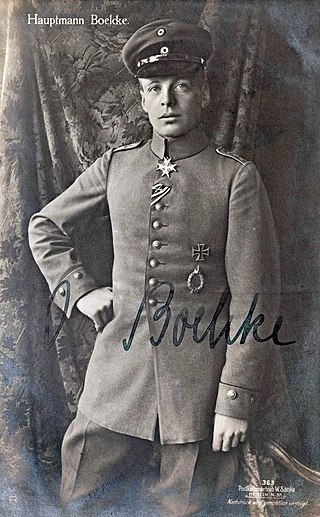
Oswald Boelcke PlM was a World War I German professional soldier and pioneering flying ace credited with 40 aerial victories. Boelcke is honored as the father of the German fighter air force, and of air combat as a whole. He was a highly influential mentor, patrol leader, and tactician in the first years of air combat, 1915 and 1916.
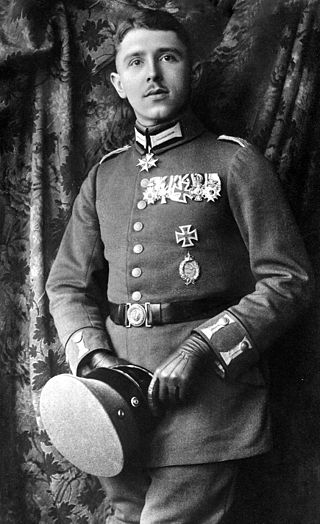
Max ImmelmannPLM was the first German World War I flying ace. He was a pioneer in fighter aviation and is often mistakenly credited with the first aerial victory using a synchronized gun, which was in fact achieved on 1 July 1915 by the German ace Kurt Wintgens. He was the first aviator to receive the Pour le Mérite, being awarded it at the same time as Oswald Boelcke. His name has become attached to a common flying tactic, the Immelmann turn, and remains a byword in aviation. He is credited with 15 aerial victories.

The Fokker E.V was a German parasol-monoplane fighter aircraft designed by Reinhold Platz and built by Fokker-Flugzeugwerke. The E.V was the last Fokker design to become operational with the Luftstreitkräfte, entering service in the last months of World War I. After several fatal accidents due to wing failures, the aircraft was modified and redesignated Fokker D.VIII. Dubbed the Flying Razor by post-war pulp-fiction writers, the D.VIII had the distinction of scoring the last aerial victory of the war.

The Fokker Eindecker fighters were a series of German World War I monoplane single-seat fighter aircraft designed by Dutch engineer Anthony Fokker. Developed in April 1915, the first Eindecker ("Monoplane") was the first purpose-built German fighter aircraft and the first aircraft to be fitted with a synchronization gear, enabling the pilot to fire a machine gun through the arc of the propeller without striking the blades. The Eindecker gave the German Army's Air Service (then the Fliegertruppen des deutschen Kaiserreiches) a degree of air superiority from July 1915 until early 1916. This period, during which Allied aviators regarded their poorly armed aircraft as "Fokker Fodder", became known as the "Fokker Scourge".

The Fokker E.I was the first fighter aircraft to enter service with the Fliegertruppe of the Deutsches Heer in World War I. Its arrival at the front in mid-1915 marked the start of a period known as the "Fokker Scourge" during which the E.I and its successors achieved a measure of air superiority over the Western Front.
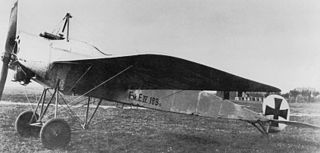
The Fokker E.IV was the final variant of the Eindecker fighter aircraft that was operated by Germany during World War I.
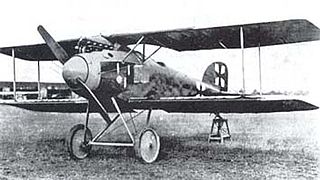
The Albatros D.II was a German fighter aircraft used during World War I. After a successful combat career in the early Jagdstaffeln, it was gradually superseded by the Albatros D.III.

The Albatros D.V is a fighter aircraft built by the Albatros Flugzeugwerke and used by the Luftstreitkräfte during World War I. The D.V was the final development of the Albatros D.I family and the last Albatros fighter to see operational service. Despite its well-known shortcomings and general obsolescence, approximately 900 D.V and 1,612 D.Va aircraft were built before production halted in April 1918. The D.Va continued in operational service until the end of the war.

The Pfalz D.III was a fighter aircraft used by the Luftstreitkräfte during the First World War. The D.III was the first major original design from Pfalz Flugzeugwerke. Though generally considered inferior to contemporary Albatros and Fokker fighters, the D.III was widely used by the Jagdstaffeln from late 1917 to mid-1918. It continued to serve as a training aircraft until the end of the war.
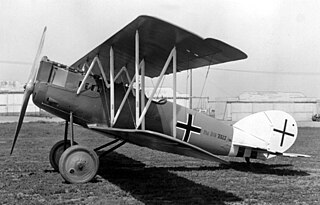
The Pfalz D.XII was a German fighter aircraft built by Pfalz Flugzeugwerke. Designed by Rudolph Gehringer as a successor to the Pfalz D.III, the D.XII entered service in significant numbers near the end of the First World War. It was the last Pfalz aircraft to see widespread service. Though the D.XII was an effective fighter aircraft, it was overshadowed by the highly successful Fokker D.VII.

The Fokker V.1 was a small German sesquiplane experimental fighter prototype built in 1916 by the Fokker-Flugzeugwerke. Sporting a parasol wing, it was the first Fokker aircraft purportedly designed by Reinhold Platz—the respective roles played by Fokker himself, Platz, and possibly others in the conceptual design of Fokker airplanes are a matter of dispute among historians—and was an early experiment in cantilever wing construction, eliminating the bracing wires typical of aircraft design at the time, something that had already been achieved with metal materials in Hugo Junkers' own pioneering Junkers J 1 in 1915.
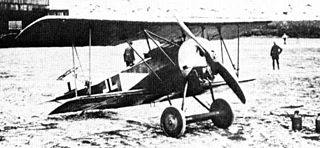
The Fokker D.VI was a German fighter aircraft built in limited numbers at the end of World War I. The D.VI served in the German and Austro-Hungarian air services.

The Fokker D.IV was a German fighter biplane of World War I, a development of the D.I.

The Fokker D.V was a German biplane fighter of World War I.
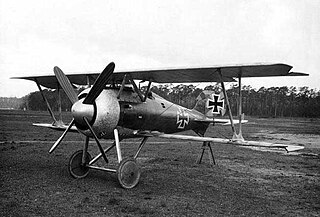
The Siemens-Schuckert D.III was a German single-seat fighter built by Siemens-Schuckert Werke. The D.III was a development of the earlier Siemens-Schuckert D.IIc prototype. The D.III was an (nearly) equal-span biplane powered by a 160 hp (119 kW) Siemens-Halske Sh.III bi-rotary engine. Idflieg placed an order for 20 aircraft in December 1917, followed by a second order of 30 aircraft in February 1918.

The Roland D.VI was a German fighter aircraft built at the end of World War I. It lost a fly-off to the Fokker D.VII, but production went ahead anyway as insurance against problems with the Fokker.
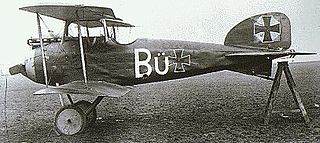
Jasta 2 was one of the best-known German Luftstreitkräfte Squadrons in World War I. Its first commanding officer was the great aerial tactician Oswald Boelcke, and it was the incubator of several notable aviation careers.
The Kondor E 3, sometimes erroneously known as E.III, was a German single seat, monoplane fighter aircraft designed and built close to the end of World War I. Though successful in the third D-type fighter competition at Aldershof in September 1918, only a few were produced, given the Idflieg designation of Kondor D.I.





















